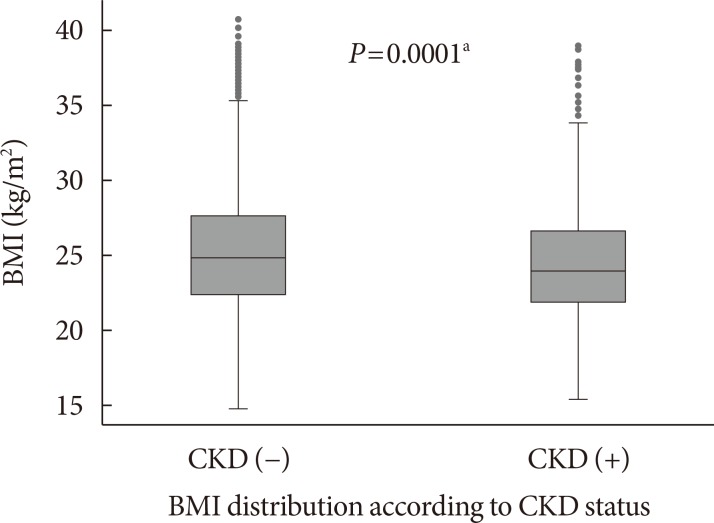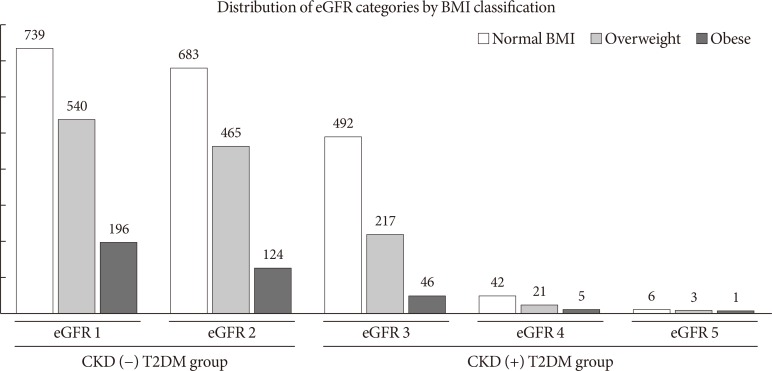Diabetes Metab J.
2018 Aug;42(4):330-337. 10.4093/dmj.2017.0052.
Associations between Body Mass Index and Chronic Kidney Disease in Type 2 Diabetes Mellitus Patients: Findings from the Northeast of Thailand
- Affiliations
-
- 1Faculty of Public Health, Khon Kaen University, Khon Kaen, Thailand. sojib@icddrb.org
- 2Maternal and Child Health Division, International Centre for Diarrhoeal Disease Research, Bangladesh (icddr,b), Dhaka, Bangladesh.
- 3Institute of Tropical Medicine and International Health Berlin, Charite-University Medicine, Berlin, Germany.
- 4Department of Pharmacology, Dhaka Medical College, Dhaka, Bangladesh.
- 5School of Public Health, University of Queensland, Brisbane, Australia.
- KMID: 2418721
- DOI: http://doi.org/10.4093/dmj.2017.0052
Abstract
- BACKGROUND
Chronic kidney disease (CKD) has emerged as a public health burden globally. Obesity and long-term hyperglycaemia can initiate the renal vascular complications in patients with type 2 diabetes mellitus (T2DM). This study aimed to investigate the association of body mass index (BMI) with the CKD in patients with T2DM.
METHODS
This study has used retrospective medical records, biochemical reports, and anthropometric measurements of 3,580 T2DM patients which were collected between January to December 2015 from a district hospital in Thailand. CKD was defined according to the measurement of estimated glomerular filtration rate ( < 60 mL/min/1.73 m2). Multiple logistic regression analysis was used to explore the association between BMI and CKD in patients with T2DM.
RESULTS
The mean age of the participants was 60.86±9.67 years, 53.68% had poor glycaemic control, and 45.21% were overweight. About one-in-four (23.26%) T2DM patients had CKD. The mean BMI of non-CKD group was slightly higher (25.30 kg/m2 vs. 24.30 kg/m2) when compared with CKD patients. Multivariable analysis showed that older age, female sex, hypertension, and microalbuminuria were associated with the presence of CKD. No association was observed between CKD and poorly controlled glycosylated hemoglobin or hypercholesterolemia. Adjusted analysis further showed overweight and obesity were negatively associated with CKD (adjusted odds ratio [AOR], 0.73; 95% confidence interval [CI], 0.58 to 0.93) and (AOR, 0.53; 95% CI, 0.35 to 0.81), respectively.
CONCLUSION
The negative association of BMI with CKD could reflect the reverse causality. Lower BMI might not lead a diabetic patient to develop CKD, but there are possibilities that CKD leads the patient to experience reduced BMI.
MeSH Terms
-
Body Mass Index*
Diabetes Mellitus, Type 2*
Female
Glomerular Filtration Rate
Hemoglobin A, Glycosylated
Hospitals, District
Humans
Hypercholesterolemia
Hypertension
Kidney Diseases
Logistic Models
Medical Records
Obesity
Odds Ratio
Overweight
Public Health
Renal Insufficiency, Chronic*
Retrospective Studies
Thailand*
Figure
Reference
-
1. WHO Expert Consultation. Appropriate body-mass index for Asian populations and its implications for policy and intervention strategies. Lancet. 2004; 363:157–163. PMID: 14726171.3. Schneider C, Coll B, Jick SS, Meier CR. Doubling of serum creatinine and the risk of cardiovascular outcomes in patients with chronic kidney disease and type 2 diabetes mellitus: a cohort study. Clin Epidemiol. 2016; 8:177–184. PMID: 27354825.4. Chittinandana A. Thailand renal replacement therapy registry (TRT Registry) report. J Nephrol Soc Thai. 2000; 6:250–255.5. van Dieren S, Beulens JW, van der Schouw YT, Grobbee DE, Neal B. The global burden of diabetes and its complications: an emerging pandemic. Eur J Cardiovasc Prev Rehabil. 2010; 17(Suppl 1):S3–S8. PMID: 20489418.6. Shaw JE, Sicree RA, Zimmet PZ. Global estimates of the prevalence of diabetes for 2010 and 2030. Diabetes Res Clin Pract. 2010; 87:4–14. PMID: 19896746.
Article7. Zaman SB. Detection of chronic kidney disease by using different equations of glomerular filtration rate in patients with type 2 diabetes mellitus: a cross-sectional analysis. Cureus. 2017; 9:e1352. PMID: 28721320.
Article8. Muktabhant B, Sanchaisuriya P, Sarakarn P, Tawityanon W, Trakulwong M, Worawat S, Schelp FP. Use of glucometer and fasting blood glucose as screening tools for diabetes mellitus type 2 and glycated haemoglobin as clinical reference in rural community primary care settings of a middle income country. BMC Public Health. 2012; 12:349. PMID: 22583817.
Article9. Rossing K, Christensen PK, Hovind P, Tarnow L, Rossing P, Parving HH. Progression of nephropathy in type 2 diabetic patients. Kidney Int. 2004; 66:1596–1605. PMID: 15458456.
Article10. Rossing P, Rossing K, Jacobsen P, Parving HH. Unchanged incidence of diabetic nephropathy in IDDM patients. Diabetes. 1995; 44:739–743. PMID: 7789641.
Article11. Zaman SB, Hossain N, Rahman AE, Islam SMS. Can glycated hemoglobin act as a reliable glycemic indicator in patients with diabetic chronic kidney disease? Evidence from the Northeast of Thailand. Med J Indones. 2017; 26:102–108.
Article12. Bhutani J, Bhutani S. Worldwide burden of diabetes. Indian J Endocrinol Metab. 2014; 18:868–870. PMID: 25364686.
Article13. Zaman SB, Karim MA, Hossain N, Al Kibria GM, Islam SMS. Plasma triglycerides as a risk factor for chronic kidney disease in type 2 diabetes mellitus: evidence from northeastern Thailand. Diabetes Res Clin Pract. 2018; 138:238–245. PMID: 29448006.
Article14. Bae JP, Lage MJ, Mo D, Nelson DR, Hoogwerf BJ. Obesity and glycemic control in patients with diabetes mellitus: analysis of physician electronic health records in the US from 2009-2011. J Diabetes Complications. 2016; 30:212–220. PMID: 26689451.
Article15. Agarwal R, Light RP. Relationship between glycosylated hemoglobin and blood glucose during progression of chronic kidney disease. Am J Nephrol. 2011; 34:32–41. PMID: 21659737.
Article16. Johansen KL, Young B, Kaysen GA, Chertow GM. Association of body size with outcomes among patients beginning dialysis. Am J Clin Nutr. 2004; 80:324–332. PMID: 15277152.
Article17. Kalantar-Zadeh K, Kuwae N, Wu DY, Shantouf RS, Fouque D, Anker SD, Block G, Kopple JD. Associations of body fat and its changes over time with quality of life and prospective mortality in hemodialysis patients. Am J Clin Nutr. 2006; 83:202–210. PMID: 16469976.
Article18. Kalantar-Zadeh K, Abbott KC, Salahudeen AK, Kilpatrick RD, Horwich TB. Survival advantages of obesity in dialysis patients. Am J Clin Nutr. 2005; 81:543–554. PMID: 15755821.
Article19. Mafra D, Guebre-Egziabher F, Fouque D. Body mass index, muscle and fat in chronic kidney disease: questions about survival. Nephrol Dial Transplant. 2008; 23:2461–2466. PMID: 18390566.
Article20. Hogg RJ, Furth S, Lemley KV, Portman R, Schwartz GJ, Coresh J, Balk E, Lau J, Levin A, Kausz AT, Eknoyan G, Levey AS. National Kidney Foundation's Kidney Disease Outcomes Quality Initiative. National Kidney Foundation's Kidney Disease Outcomes Quality Initiative clinical practice guidelines for chronic kidney disease in children and adolescents: evaluation, classification, and stratification. Pediatrics. 2003; 111:1416–1421. PMID: 12777562.
Article21. WHO Guidelines Approved by the Guidelines Review Committee. Use of glycated haemoglobin (HbA1c) in the diagnosis of diabetes mellitus: abbreviated report of a WHO Consultation. Geneva: World Health Organization;2011.22. World Health Organization: BMI classification. updated 2018 Mar 29. Available from: http://apps.who.int/bmi/index.jsp?introPage=intro_3.html.23. Domrongkitchaiporn S, Sritara P, Kitiyakara C, Stitchantrakul W, Krittaphol V, Lolekha P, Cheepudomwit S, Yipintsoi T. Risk factors for development of decreased kidney function in a Southeast Asian population: a 12-year cohort study. J Am Soc Nephrol. 2005; 16:791–799. PMID: 15677313.
Article24. Jellinger PS, Smith DA, Mehta AE, Ganda O, Handelsman Y, Rodbard HW, Shepherd MD, Seibel JA. AACE Task Force for Management of Dyslipidemia and Prevention of Atherosclerosis. American Association of Clinical Endocrinologists' guidelines for management of dyslipidemia and prevention of atherosclerosis. Endocr Pract. 2012; 18(Suppl 1):1–78. PMID: 22522068.
Article25. StataCorp: 2013 Stata Statistical Software: Release 13. College Station, TX: StataCorp LP;cited 2018 Mar 30. Available from: http://www.stata.com/support/faqs/resources/citing-software-documentation-faqs/.26. Fox CS, Larson MG, Leip EP, Culleton B, Wilson PW, Levy D. Predictors of new-onset kidney disease in a community-based population. JAMA. 2004; 291:844–850. PMID: 14970063.
Article27. Janssen I, Katzmarzyk PT, Ross R. Waist circumference and not body mass index explains obesity-related health risk. Am J Clin Nutr. 2004; 79:379–384. PMID: 14985210.
Article28. Galal W, van Domburg RT, Feringa HH, Schouten O, Elhendy A, Bax JJ, Awara AM, Klein J, Poldermans D. Relation of body mass index to outcome in patients with known or suspected coronary artery disease. Am J Cardiol. 2007; 99:1485–1490. PMID: 17531566.
Article29. Ramirez SP, McClellan W, Port FK, Hsu SI. Risk factors for proteinuria in a large, multiracial, Southeast Asian population. J Am Soc Nephrol. 2002; 13:1907–1917. PMID: 12089388.
Article30. Rifkin DE, Shlipak MG, Katz R, Fried LF, Siscovick D, Chonchol M, Newman AB, Sarnak MJ. Rapid kidney function decline and mortality risk in older adults. Arch Intern Med. 2008; 168:2212–2218. PMID: 19001197.
Article31. Lee PH, Chang HY, Tung CW, Hsu YC, Lei CC, Chang HH, Yang HF, Lu LC, Jong MC, Chen CY, Fang KY, Chao YS, Shih YH, Lin CL. Hypertriglyceridemia: an independent risk factor of chronic kidney disease in Taiwanese adults. Am J Med Sci. 2009; 338:185–189. PMID: 19657271.
Article32. Jha V, Garcia-Garcia G, Iseki K, Li Z, Naicker S, Plattner B, Saran R, Wang AY, Yang CW. Chronic kidney disease: global dimension and perspectives. Lancet. 2013; 382:260–272. PMID: 23727169.
Article
- Full Text Links
- Actions
-
Cited
- CITED
-
- Close
- Share
- Similar articles
-
- Soluble Dipeptidyl Peptidase-4 Levels Are Associated with Decreased Renal Function in Patients with Type 2 Diabetes Mellitus
- The Evidence for an Obesity Paradox in Type 2 Diabetes Mellitus
- Associations among Body Mass Index, Insulin Resistance, and Pancreatic beta-Cell Function in Korean Patients with New-Onset Type 2 Diabetes
- Comparison of the Efficacy of Dipeptidylpeptidase-4 Inhibitors Between Asian and Non-Asian Populations
- Serum Branched Chain Amino Acids Are Associated with Type 2 Diabetes Mellitus in Jordan



